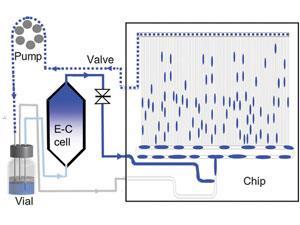
Many industrial processes are catalysed by enzymes, and one class of enzyme, oxidoreductases, could be very useful redox biocatalysts for the production of specialty chemicals and pharmaceuticals. However, oxidoreductases require expensive co-factors – non-protein compounds that activate enzymes – and this makes them less economically feasible for industrial use. Some methods have been developed to recycle or regenerate co-factors, but these are also expensive, and can produce unwanted side-reactions.
Now Stephan Mohr and colleagues have designed an efficient microfluidic biocatalysis device that uses and regenerates an artificial mediator, dimethyl viologen, which is cheaper than co-factors used currently. The mediator and enzyme solution is drawn through an electrochemical cell that removes an electron from the mediator and adds it to the enzyme, thereby activating it. The pump then pulls the solution onto a chip, where it combines with the substrate solution so that the activated enzyme catalyses the desired reaction, forming the product. The biphasic solution containing the product, enzyme and mediator is then pumped into a vial where the product can be separated.
Stefan Lutz, an expert in biocatalysis at Emory University, US, says ‘the work offers an interesting new approach for co-factor regeneration and highlights some of the lesser-known employment opportunities for microfluidic devices.’ But he warns ‘the toxicity of dimethyl viologen is a concern that will likely restrict the application of the technology in certain processes’.
Mohr says ‘The prototype reactor we have developed establishes an important proof of principle that is potentially operable with a wide range of enzyme catalysts.’ The team have successfully tested the system with two enzymes, and their future work will now involve testing it with different biocatalysts and reagents, building devices for a range of bioreactions.
References
K Fisher, S Mohr, D Mansell, N J Goddard, P R Fielden and N S Scrutton, Catal. Sci. Technol., 2013, DOI:10.1039/c3cy20720j






No comments yet